Theories of Language Acquisition and Attachment in Childhood
VerifiedAdded on 2022/11/30
|8
|2284
|349
AI Summary
This article discusses the theories of language acquisition and attachment in childhood. It explores the role of nature and nurture in language acquisition, compares and contrasts different approaches, and examines Bowlby's theory of attachment formation. The article also discusses classical conditioning explanation, evaluates the learning theory using Harlow's research, and explores Bowlby's maternal deprivation hypothesis.
Contribute Materials
Your contribution can guide someone’s learning journey. Share your
documents today.
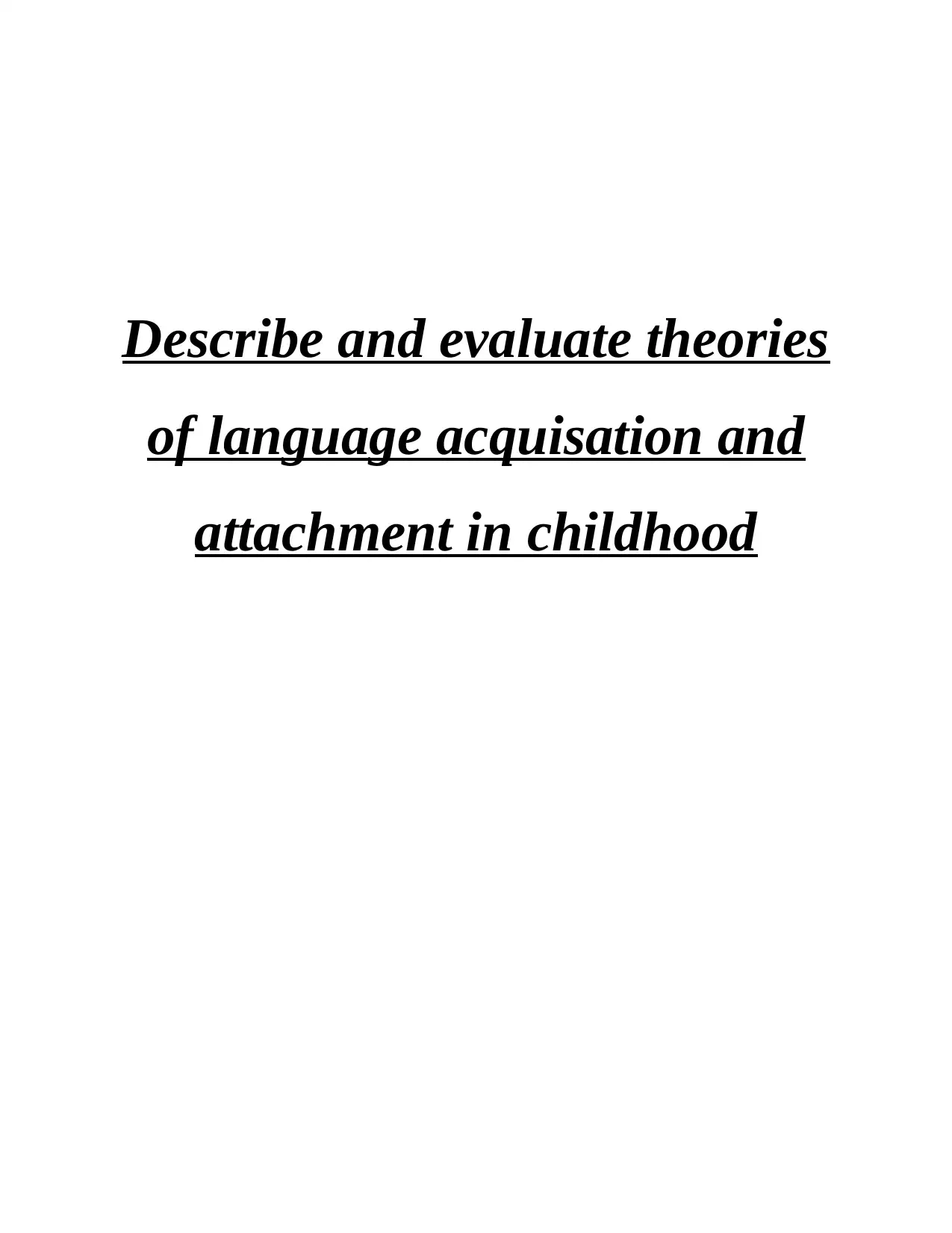
Describe and evaluate theories
of language acquisation and
attachment in childhood
of language acquisation and
attachment in childhood
Secure Best Marks with AI Grader
Need help grading? Try our AI Grader for instant feedback on your assignments.
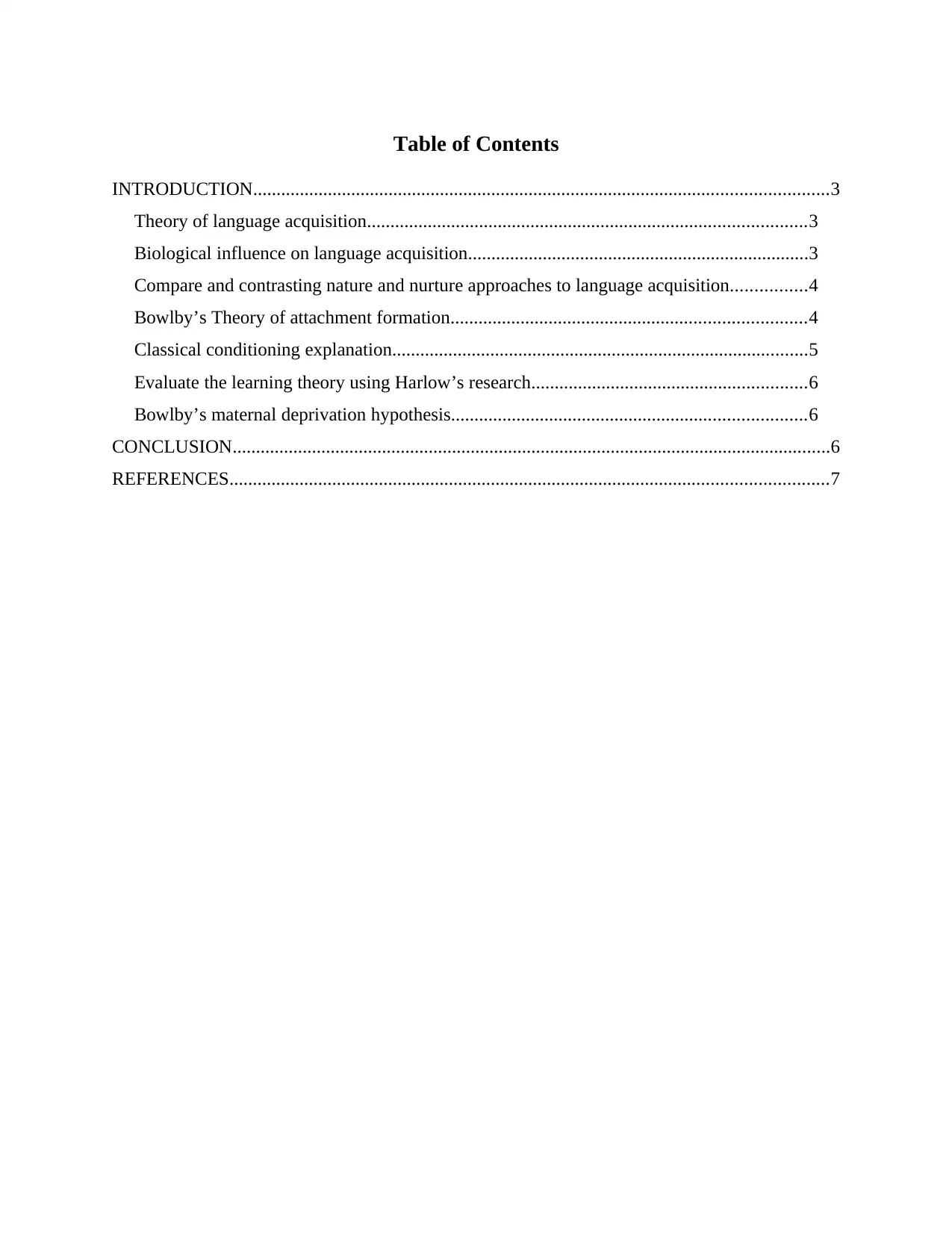
Table of Contents
INTRODUCTION...........................................................................................................................3
Theory of language acquisition..............................................................................................3
Biological influence on language acquisition.........................................................................3
Compare and contrasting nature and nurture approaches to language acquisition................4
Bowlby’s Theory of attachment formation............................................................................4
Classical conditioning explanation.........................................................................................5
Evaluate the learning theory using Harlow’s research...........................................................6
Bowlby’s maternal deprivation hypothesis............................................................................6
CONCLUSION................................................................................................................................6
REFERENCES................................................................................................................................7
INTRODUCTION...........................................................................................................................3
Theory of language acquisition..............................................................................................3
Biological influence on language acquisition.........................................................................3
Compare and contrasting nature and nurture approaches to language acquisition................4
Bowlby’s Theory of attachment formation............................................................................4
Classical conditioning explanation.........................................................................................5
Evaluate the learning theory using Harlow’s research...........................................................6
Bowlby’s maternal deprivation hypothesis............................................................................6
CONCLUSION................................................................................................................................6
REFERENCES................................................................................................................................7
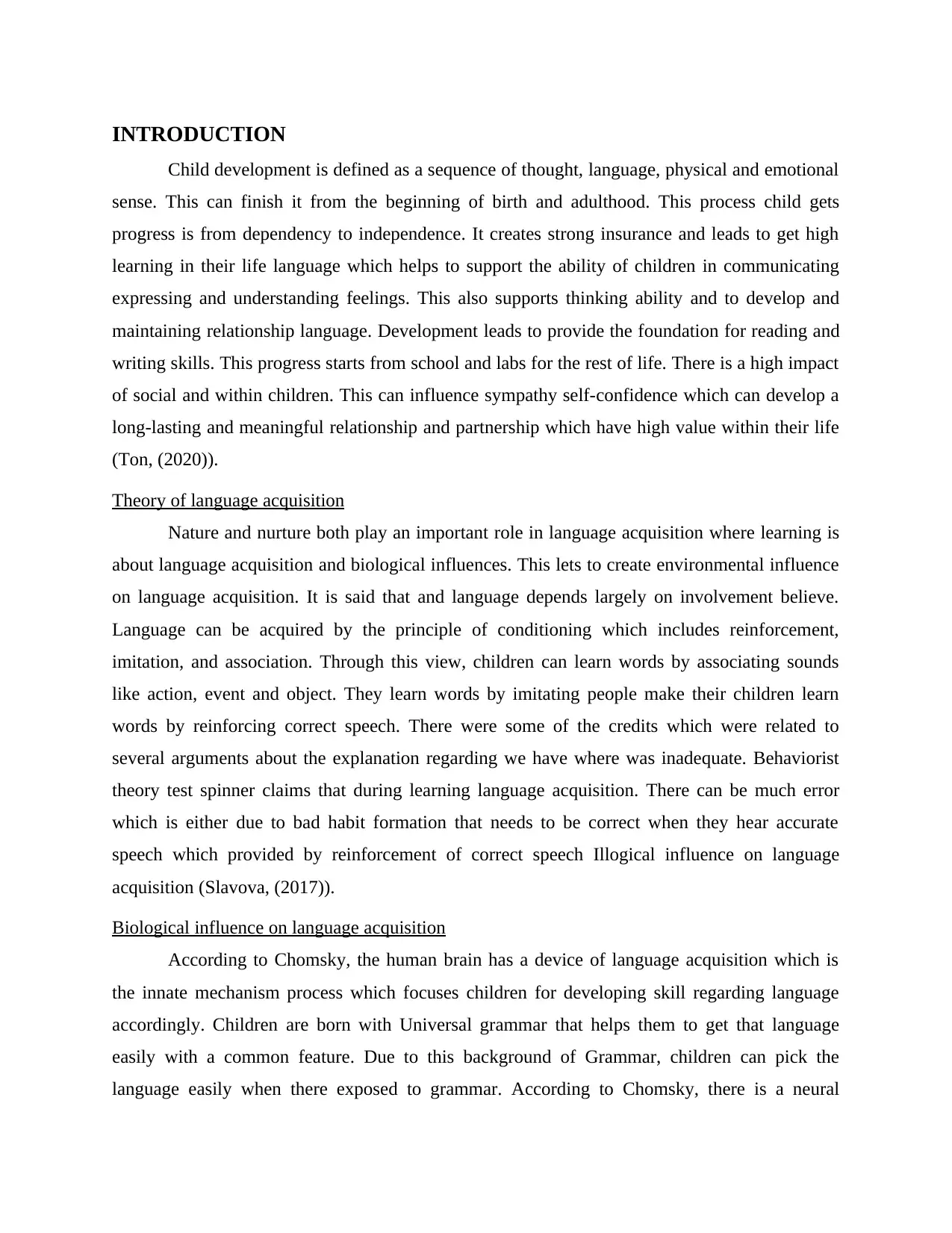
INTRODUCTION
Child development is defined as a sequence of thought, language, physical and emotional
sense. This can finish it from the beginning of birth and adulthood. This process child gets
progress is from dependency to independence. It creates strong insurance and leads to get high
learning in their life language which helps to support the ability of children in communicating
expressing and understanding feelings. This also supports thinking ability and to develop and
maintaining relationship language. Development leads to provide the foundation for reading and
writing skills. This progress starts from school and labs for the rest of life. There is a high impact
of social and within children. This can influence sympathy self-confidence which can develop a
long-lasting and meaningful relationship and partnership which have high value within their life
(Ton, (2020)).
Theory of language acquisition
Nature and nurture both play an important role in language acquisition where learning is
about language acquisition and biological influences. This lets to create environmental influence
on language acquisition. It is said that and language depends largely on involvement believe.
Language can be acquired by the principle of conditioning which includes reinforcement,
imitation, and association. Through this view, children can learn words by associating sounds
like action, event and object. They learn words by imitating people make their children learn
words by reinforcing correct speech. There were some of the credits which were related to
several arguments about the explanation regarding we have where was inadequate. Behaviorist
theory test spinner claims that during learning language acquisition. There can be much error
which is either due to bad habit formation that needs to be correct when they hear accurate
speech which provided by reinforcement of correct speech Illogical influence on language
acquisition (Slavova, (2017)).
Biological influence on language acquisition
According to Chomsky, the human brain has a device of language acquisition which is
the innate mechanism process which focuses children for developing skill regarding language
accordingly. Children are born with Universal grammar that helps them to get that language
easily with a common feature. Due to this background of Grammar, children can pick the
language easily when there exposed to grammar. According to Chomsky, there is a neural
Child development is defined as a sequence of thought, language, physical and emotional
sense. This can finish it from the beginning of birth and adulthood. This process child gets
progress is from dependency to independence. It creates strong insurance and leads to get high
learning in their life language which helps to support the ability of children in communicating
expressing and understanding feelings. This also supports thinking ability and to develop and
maintaining relationship language. Development leads to provide the foundation for reading and
writing skills. This progress starts from school and labs for the rest of life. There is a high impact
of social and within children. This can influence sympathy self-confidence which can develop a
long-lasting and meaningful relationship and partnership which have high value within their life
(Ton, (2020)).
Theory of language acquisition
Nature and nurture both play an important role in language acquisition where learning is
about language acquisition and biological influences. This lets to create environmental influence
on language acquisition. It is said that and language depends largely on involvement believe.
Language can be acquired by the principle of conditioning which includes reinforcement,
imitation, and association. Through this view, children can learn words by associating sounds
like action, event and object. They learn words by imitating people make their children learn
words by reinforcing correct speech. There were some of the credits which were related to
several arguments about the explanation regarding we have where was inadequate. Behaviorist
theory test spinner claims that during learning language acquisition. There can be much error
which is either due to bad habit formation that needs to be correct when they hear accurate
speech which provided by reinforcement of correct speech Illogical influence on language
acquisition (Slavova, (2017)).
Biological influence on language acquisition
According to Chomsky, the human brain has a device of language acquisition which is
the innate mechanism process which focuses children for developing skill regarding language
accordingly. Children are born with Universal grammar that helps them to get that language
easily with a common feature. Due to this background of Grammar, children can pick the
language easily when there exposed to grammar. According to Chomsky, there is a neural
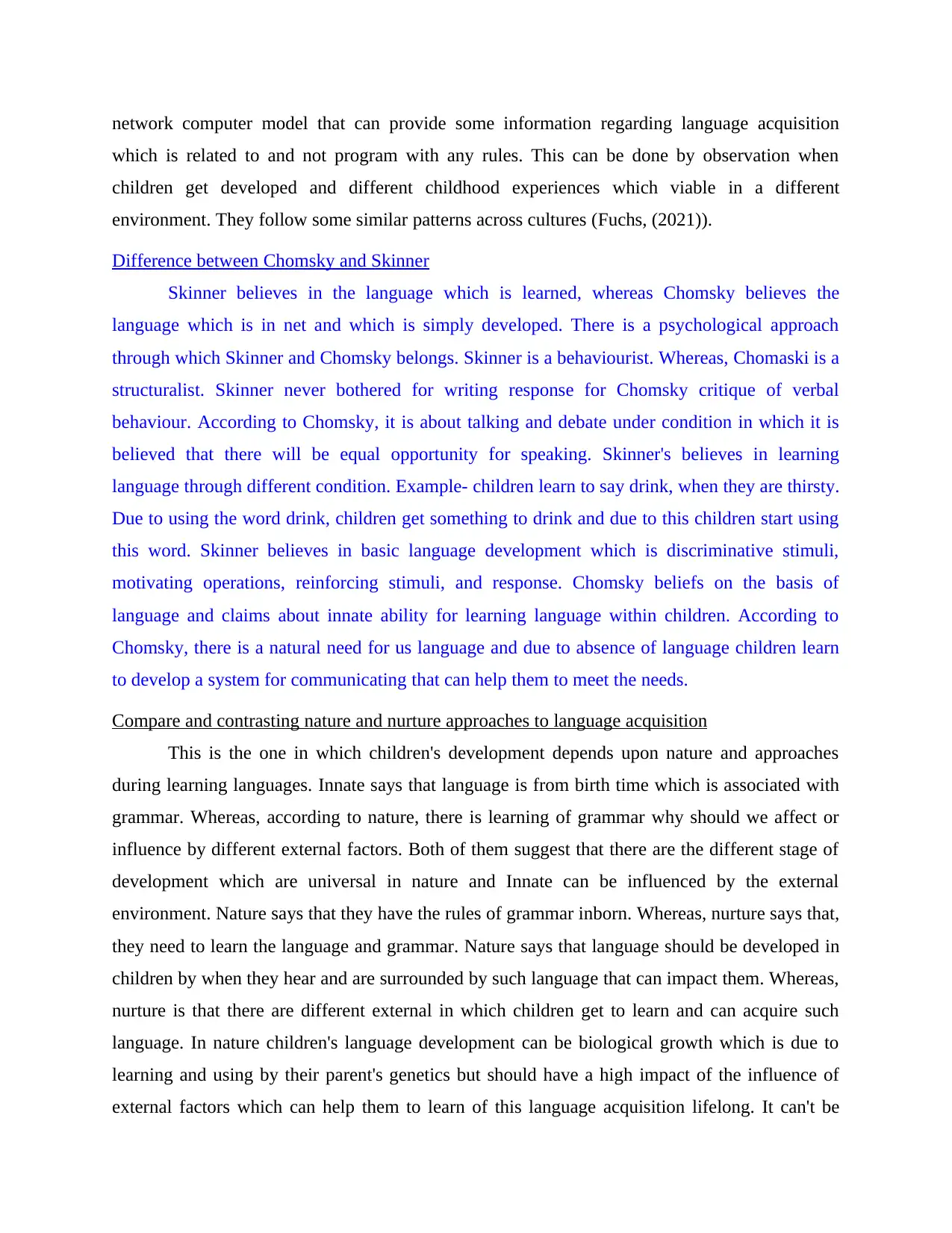
network computer model that can provide some information regarding language acquisition
which is related to and not program with any rules. This can be done by observation when
children get developed and different childhood experiences which viable in a different
environment. They follow some similar patterns across cultures (Fuchs, (2021)).
Difference between Chomsky and Skinner
Skinner believes in the language which is learned, whereas Chomsky believes the
language which is in net and which is simply developed. There is a psychological approach
through which Skinner and Chomsky belongs. Skinner is a behaviourist. Whereas, Chomaski is a
structuralist. Skinner never bothered for writing response for Chomsky critique of verbal
behaviour. According to Chomsky, it is about talking and debate under condition in which it is
believed that there will be equal opportunity for speaking. Skinner's believes in learning
language through different condition. Example- children learn to say drink, when they are thirsty.
Due to using the word drink, children get something to drink and due to this children start using
this word. Skinner believes in basic language development which is discriminative stimuli,
motivating operations, reinforcing stimuli, and response. Chomsky beliefs on the basis of
language and claims about innate ability for learning language within children. According to
Chomsky, there is a natural need for us language and due to absence of language children learn
to develop a system for communicating that can help them to meet the needs.
Compare and contrasting nature and nurture approaches to language acquisition
This is the one in which children's development depends upon nature and approaches
during learning languages. Innate says that language is from birth time which is associated with
grammar. Whereas, according to nature, there is learning of grammar why should we affect or
influence by different external factors. Both of them suggest that there are the different stage of
development which are universal in nature and Innate can be influenced by the external
environment. Nature says that they have the rules of grammar inborn. Whereas, nurture says that,
they need to learn the language and grammar. Nature says that language should be developed in
children by when they hear and are surrounded by such language that can impact them. Whereas,
nurture is that there are different external in which children get to learn and can acquire such
language. In nature children's language development can be biological growth which is due to
learning and using by their parent's genetics but should have a high impact of the influence of
external factors which can help them to learn of this language acquisition lifelong. It can't be
which is related to and not program with any rules. This can be done by observation when
children get developed and different childhood experiences which viable in a different
environment. They follow some similar patterns across cultures (Fuchs, (2021)).
Difference between Chomsky and Skinner
Skinner believes in the language which is learned, whereas Chomsky believes the
language which is in net and which is simply developed. There is a psychological approach
through which Skinner and Chomsky belongs. Skinner is a behaviourist. Whereas, Chomaski is a
structuralist. Skinner never bothered for writing response for Chomsky critique of verbal
behaviour. According to Chomsky, it is about talking and debate under condition in which it is
believed that there will be equal opportunity for speaking. Skinner's believes in learning
language through different condition. Example- children learn to say drink, when they are thirsty.
Due to using the word drink, children get something to drink and due to this children start using
this word. Skinner believes in basic language development which is discriminative stimuli,
motivating operations, reinforcing stimuli, and response. Chomsky beliefs on the basis of
language and claims about innate ability for learning language within children. According to
Chomsky, there is a natural need for us language and due to absence of language children learn
to develop a system for communicating that can help them to meet the needs.
Compare and contrasting nature and nurture approaches to language acquisition
This is the one in which children's development depends upon nature and approaches
during learning languages. Innate says that language is from birth time which is associated with
grammar. Whereas, according to nature, there is learning of grammar why should we affect or
influence by different external factors. Both of them suggest that there are the different stage of
development which are universal in nature and Innate can be influenced by the external
environment. Nature says that they have the rules of grammar inborn. Whereas, nurture says that,
they need to learn the language and grammar. Nature says that language should be developed in
children by when they hear and are surrounded by such language that can impact them. Whereas,
nurture is that there are different external in which children get to learn and can acquire such
language. In nature children's language development can be biological growth which is due to
learning and using by their parent's genetics but should have a high impact of the influence of
external factors which can help them to learn of this language acquisition lifelong. It can't be
Secure Best Marks with AI Grader
Need help grading? Try our AI Grader for instant feedback on your assignments.
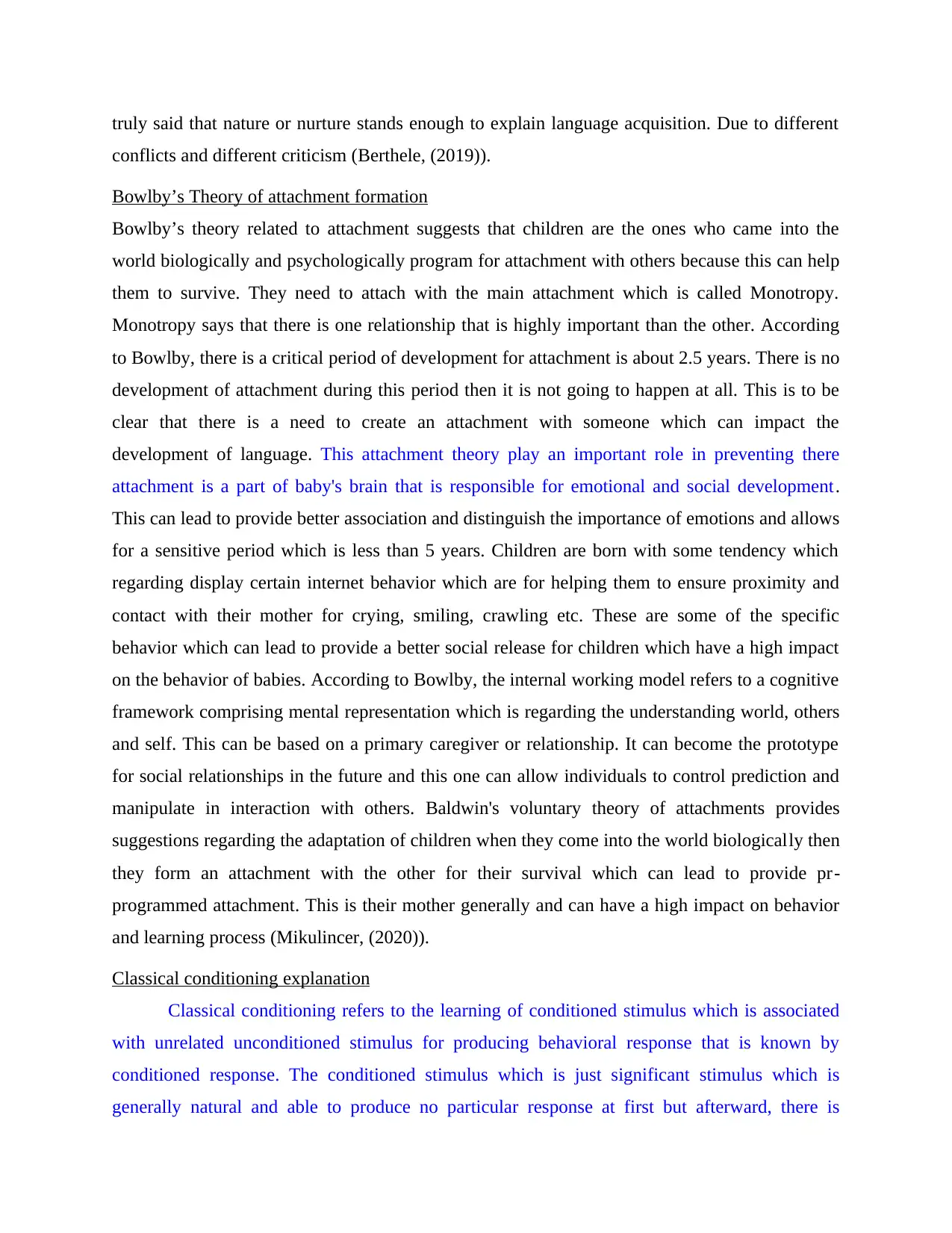
truly said that nature or nurture stands enough to explain language acquisition. Due to different
conflicts and different criticism (Berthele, (2019)).
Bowlby’s Theory of attachment formation
Bowlby’s theory related to attachment suggests that children are the ones who came into the
world biologically and psychologically program for attachment with others because this can help
them to survive. They need to attach with the main attachment which is called Monotropy.
Monotropy says that there is one relationship that is highly important than the other. According
to Bowlby, there is a critical period of development for attachment is about 2.5 years. There is no
development of attachment during this period then it is not going to happen at all. This is to be
clear that there is a need to create an attachment with someone which can impact the
development of language. This attachment theory play an important role in preventing there
attachment is a part of baby's brain that is responsible for emotional and social development.
This can lead to provide better association and distinguish the importance of emotions and allows
for a sensitive period which is less than 5 years. Children are born with some tendency which
regarding display certain internet behavior which are for helping them to ensure proximity and
contact with their mother for crying, smiling, crawling etc. These are some of the specific
behavior which can lead to provide a better social release for children which have a high impact
on the behavior of babies. According to Bowlby, the internal working model refers to a cognitive
framework comprising mental representation which is regarding the understanding world, others
and self. This can be based on a primary caregiver or relationship. It can become the prototype
for social relationships in the future and this one can allow individuals to control prediction and
manipulate in interaction with others. Baldwin's voluntary theory of attachments provides
suggestions regarding the adaptation of children when they come into the world biologically then
they form an attachment with the other for their survival which can lead to provide pr-
programmed attachment. This is their mother generally and can have a high impact on behavior
and learning process (Mikulincer, (2020)).
Classical conditioning explanation
Classical conditioning refers to the learning of conditioned stimulus which is associated
with unrelated unconditioned stimulus for producing behavioral response that is known by
conditioned response. The conditioned stimulus which is just significant stimulus which is
generally natural and able to produce no particular response at first but afterward, there is
conflicts and different criticism (Berthele, (2019)).
Bowlby’s Theory of attachment formation
Bowlby’s theory related to attachment suggests that children are the ones who came into the
world biologically and psychologically program for attachment with others because this can help
them to survive. They need to attach with the main attachment which is called Monotropy.
Monotropy says that there is one relationship that is highly important than the other. According
to Bowlby, there is a critical period of development for attachment is about 2.5 years. There is no
development of attachment during this period then it is not going to happen at all. This is to be
clear that there is a need to create an attachment with someone which can impact the
development of language. This attachment theory play an important role in preventing there
attachment is a part of baby's brain that is responsible for emotional and social development.
This can lead to provide better association and distinguish the importance of emotions and allows
for a sensitive period which is less than 5 years. Children are born with some tendency which
regarding display certain internet behavior which are for helping them to ensure proximity and
contact with their mother for crying, smiling, crawling etc. These are some of the specific
behavior which can lead to provide a better social release for children which have a high impact
on the behavior of babies. According to Bowlby, the internal working model refers to a cognitive
framework comprising mental representation which is regarding the understanding world, others
and self. This can be based on a primary caregiver or relationship. It can become the prototype
for social relationships in the future and this one can allow individuals to control prediction and
manipulate in interaction with others. Baldwin's voluntary theory of attachments provides
suggestions regarding the adaptation of children when they come into the world biologically then
they form an attachment with the other for their survival which can lead to provide pr-
programmed attachment. This is their mother generally and can have a high impact on behavior
and learning process (Mikulincer, (2020)).
Classical conditioning explanation
Classical conditioning refers to the learning of conditioned stimulus which is associated
with unrelated unconditioned stimulus for producing behavioral response that is known by
conditioned response. The conditioned stimulus which is just significant stimulus which is
generally natural and able to produce no particular response at first but afterward, there is
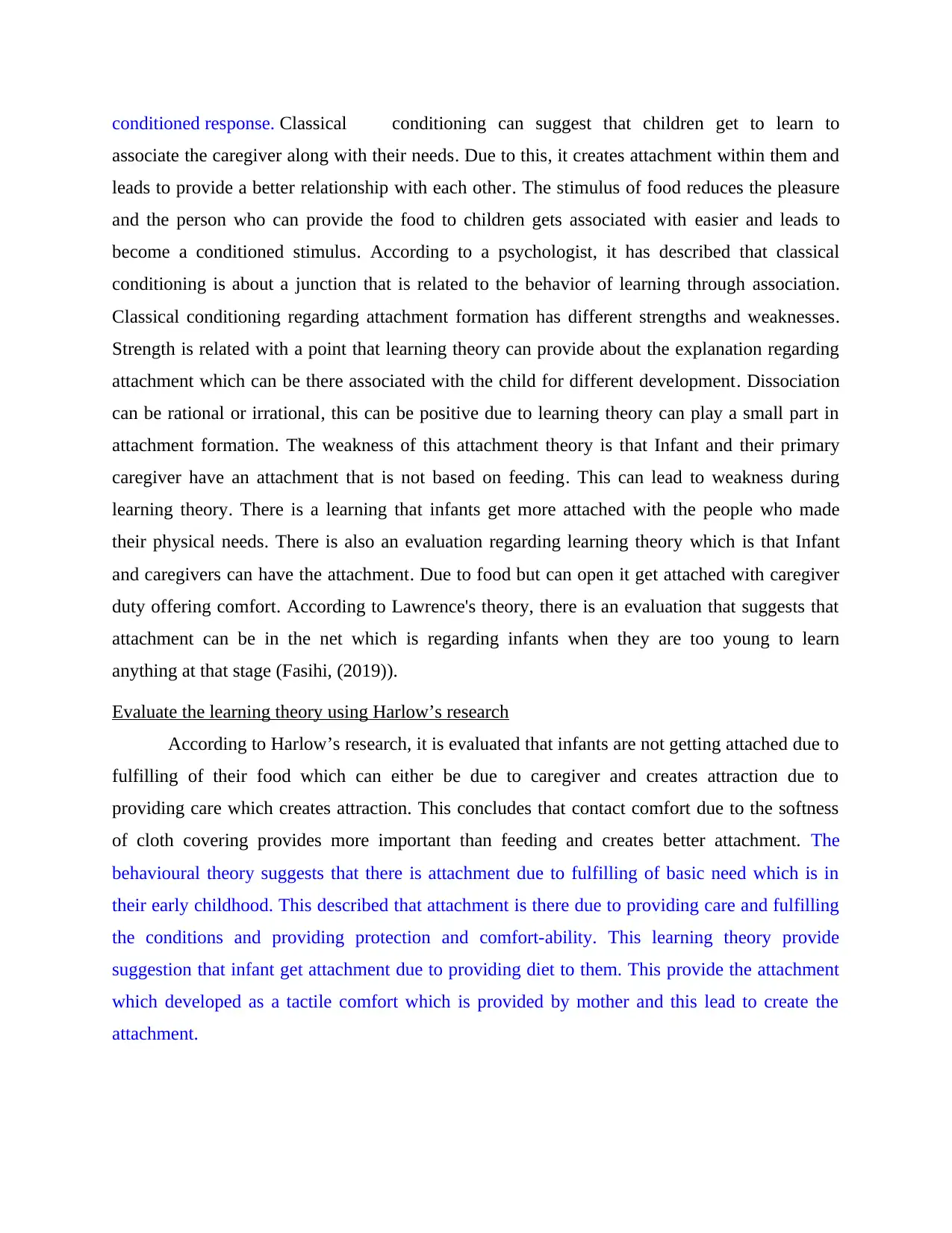
conditioned response. Classical conditioning can suggest that children get to learn to
associate the caregiver along with their needs. Due to this, it creates attachment within them and
leads to provide a better relationship with each other. The stimulus of food reduces the pleasure
and the person who can provide the food to children gets associated with easier and leads to
become a conditioned stimulus. According to a psychologist, it has described that classical
conditioning is about a junction that is related to the behavior of learning through association.
Classical conditioning regarding attachment formation has different strengths and weaknesses.
Strength is related with a point that learning theory can provide about the explanation regarding
attachment which can be there associated with the child for different development. Dissociation
can be rational or irrational, this can be positive due to learning theory can play a small part in
attachment formation. The weakness of this attachment theory is that Infant and their primary
caregiver have an attachment that is not based on feeding. This can lead to weakness during
learning theory. There is a learning that infants get more attached with the people who made
their physical needs. There is also an evaluation regarding learning theory which is that Infant
and caregivers can have the attachment. Due to food but can open it get attached with caregiver
duty offering comfort. According to Lawrence's theory, there is an evaluation that suggests that
attachment can be in the net which is regarding infants when they are too young to learn
anything at that stage (Fasihi, (2019)).
Evaluate the learning theory using Harlow’s research
According to Harlow’s research, it is evaluated that infants are not getting attached due to
fulfilling of their food which can either be due to caregiver and creates attraction due to
providing care which creates attraction. This concludes that contact comfort due to the softness
of cloth covering provides more important than feeding and creates better attachment. The
behavioural theory suggests that there is attachment due to fulfilling of basic need which is in
their early childhood. This described that attachment is there due to providing care and fulfilling
the conditions and providing protection and comfort-ability. This learning theory provide
suggestion that infant get attachment due to providing diet to them. This provide the attachment
which developed as a tactile comfort which is provided by mother and this lead to create the
attachment.
associate the caregiver along with their needs. Due to this, it creates attachment within them and
leads to provide a better relationship with each other. The stimulus of food reduces the pleasure
and the person who can provide the food to children gets associated with easier and leads to
become a conditioned stimulus. According to a psychologist, it has described that classical
conditioning is about a junction that is related to the behavior of learning through association.
Classical conditioning regarding attachment formation has different strengths and weaknesses.
Strength is related with a point that learning theory can provide about the explanation regarding
attachment which can be there associated with the child for different development. Dissociation
can be rational or irrational, this can be positive due to learning theory can play a small part in
attachment formation. The weakness of this attachment theory is that Infant and their primary
caregiver have an attachment that is not based on feeding. This can lead to weakness during
learning theory. There is a learning that infants get more attached with the people who made
their physical needs. There is also an evaluation regarding learning theory which is that Infant
and caregivers can have the attachment. Due to food but can open it get attached with caregiver
duty offering comfort. According to Lawrence's theory, there is an evaluation that suggests that
attachment can be in the net which is regarding infants when they are too young to learn
anything at that stage (Fasihi, (2019)).
Evaluate the learning theory using Harlow’s research
According to Harlow’s research, it is evaluated that infants are not getting attached due to
fulfilling of their food which can either be due to caregiver and creates attraction due to
providing care which creates attraction. This concludes that contact comfort due to the softness
of cloth covering provides more important than feeding and creates better attachment. The
behavioural theory suggests that there is attachment due to fulfilling of basic need which is in
their early childhood. This described that attachment is there due to providing care and fulfilling
the conditions and providing protection and comfort-ability. This learning theory provide
suggestion that infant get attachment due to providing diet to them. This provide the attachment
which developed as a tactile comfort which is provided by mother and this lead to create the
attachment.
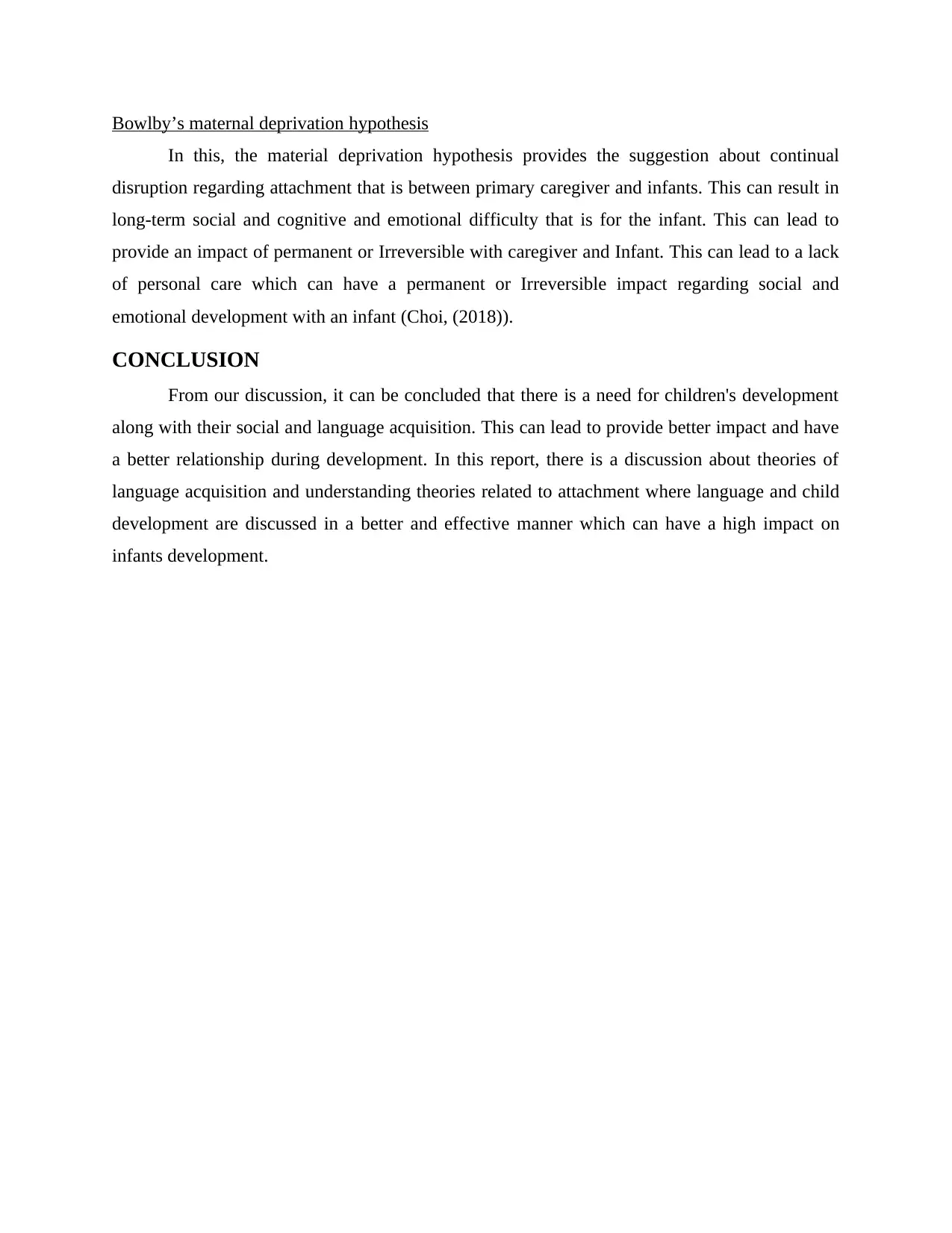
Bowlby’s maternal deprivation hypothesis
In this, the material deprivation hypothesis provides the suggestion about continual
disruption regarding attachment that is between primary caregiver and infants. This can result in
long-term social and cognitive and emotional difficulty that is for the infant. This can lead to
provide an impact of permanent or Irreversible with caregiver and Infant. This can lead to a lack
of personal care which can have a permanent or Irreversible impact regarding social and
emotional development with an infant (Choi, (2018)).
CONCLUSION
From our discussion, it can be concluded that there is a need for children's development
along with their social and language acquisition. This can lead to provide better impact and have
a better relationship during development. In this report, there is a discussion about theories of
language acquisition and understanding theories related to attachment where language and child
development are discussed in a better and effective manner which can have a high impact on
infants development.
In this, the material deprivation hypothesis provides the suggestion about continual
disruption regarding attachment that is between primary caregiver and infants. This can result in
long-term social and cognitive and emotional difficulty that is for the infant. This can lead to
provide an impact of permanent or Irreversible with caregiver and Infant. This can lead to a lack
of personal care which can have a permanent or Irreversible impact regarding social and
emotional development with an infant (Choi, (2018)).
CONCLUSION
From our discussion, it can be concluded that there is a need for children's development
along with their social and language acquisition. This can lead to provide better impact and have
a better relationship during development. In this report, there is a discussion about theories of
language acquisition and understanding theories related to attachment where language and child
development are discussed in a better and effective manner which can have a high impact on
infants development.
Paraphrase This Document
Need a fresh take? Get an instant paraphrase of this document with our AI Paraphraser
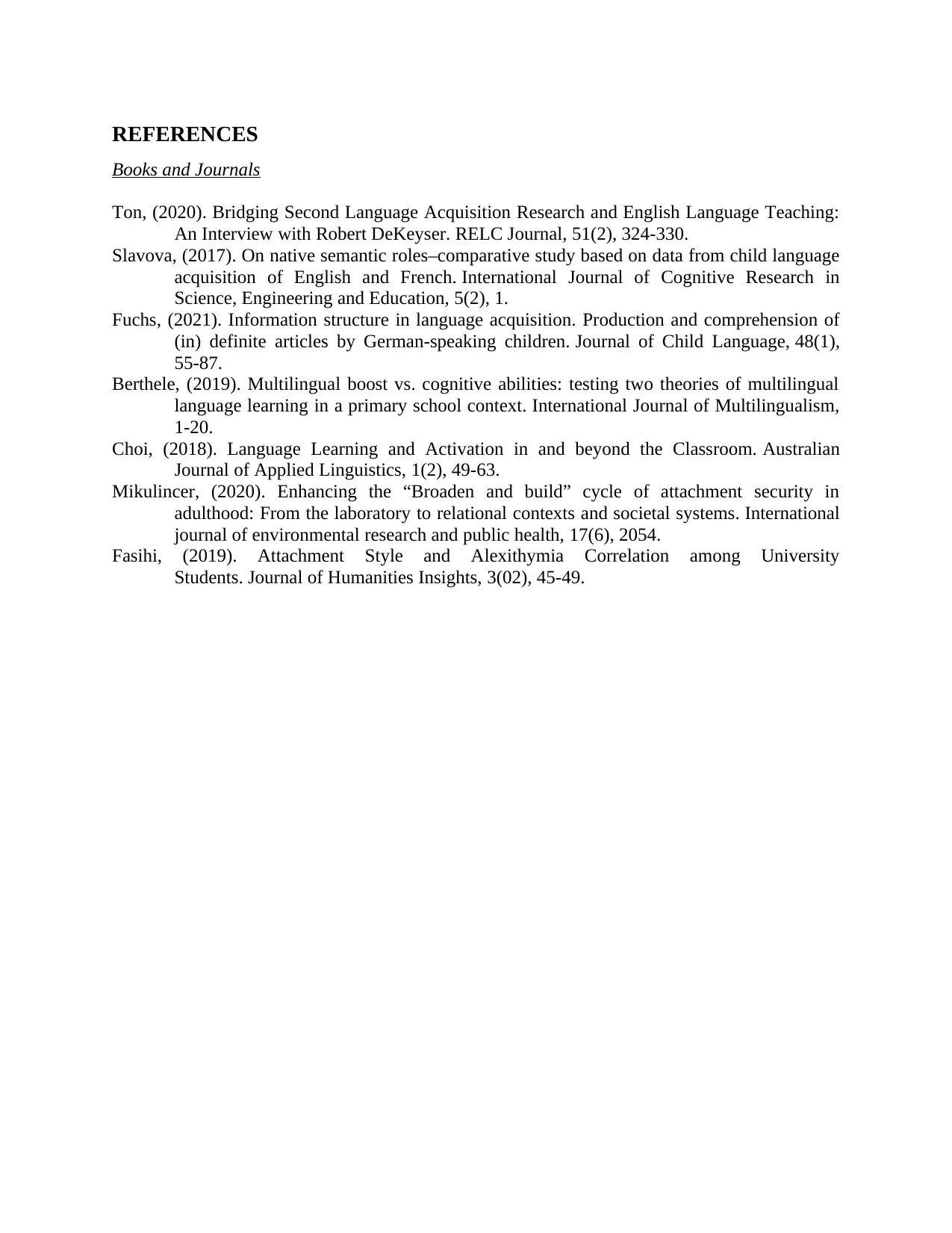
REFERENCES
Books and Journals
Ton, (2020). Bridging Second Language Acquisition Research and English Language Teaching:
An Interview with Robert DeKeyser. RELC Journal, 51(2), 324-330.
Slavova, (2017). On native semantic roles–comparative study based on data from child language
acquisition of English and French. International Journal of Cognitive Research in
Science, Engineering and Education, 5(2), 1.
Fuchs, (2021). Information structure in language acquisition. Production and comprehension of
(in) definite articles by German-speaking children. Journal of Child Language, 48(1),
55-87.
Berthele, (2019). Multilingual boost vs. cognitive abilities: testing two theories of multilingual
language learning in a primary school context. International Journal of Multilingualism,
1-20.
Choi, (2018). Language Learning and Activation in and beyond the Classroom. Australian
Journal of Applied Linguistics, 1(2), 49-63.
Mikulincer, (2020). Enhancing the “Broaden and build” cycle of attachment security in
adulthood: From the laboratory to relational contexts and societal systems. International
journal of environmental research and public health, 17(6), 2054.
Fasihi, (2019). Attachment Style and Alexithymia Correlation among University
Students. Journal of Humanities Insights, 3(02), 45-49.
Books and Journals
Ton, (2020). Bridging Second Language Acquisition Research and English Language Teaching:
An Interview with Robert DeKeyser. RELC Journal, 51(2), 324-330.
Slavova, (2017). On native semantic roles–comparative study based on data from child language
acquisition of English and French. International Journal of Cognitive Research in
Science, Engineering and Education, 5(2), 1.
Fuchs, (2021). Information structure in language acquisition. Production and comprehension of
(in) definite articles by German-speaking children. Journal of Child Language, 48(1),
55-87.
Berthele, (2019). Multilingual boost vs. cognitive abilities: testing two theories of multilingual
language learning in a primary school context. International Journal of Multilingualism,
1-20.
Choi, (2018). Language Learning and Activation in and beyond the Classroom. Australian
Journal of Applied Linguistics, 1(2), 49-63.
Mikulincer, (2020). Enhancing the “Broaden and build” cycle of attachment security in
adulthood: From the laboratory to relational contexts and societal systems. International
journal of environmental research and public health, 17(6), 2054.
Fasihi, (2019). Attachment Style and Alexithymia Correlation among University
Students. Journal of Humanities Insights, 3(02), 45-49.
1 out of 8
Related Documents
Your All-in-One AI-Powered Toolkit for Academic Success.
+13062052269
info@desklib.com
Available 24*7 on WhatsApp / Email
![[object Object]](/_next/static/media/star-bottom.7253800d.svg)
Unlock your academic potential
© 2024 | Zucol Services PVT LTD | All rights reserved.





